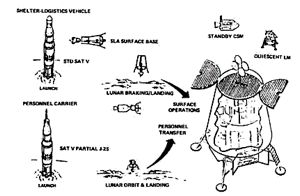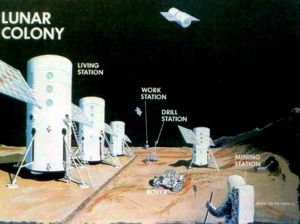
Home - Search - Browse - Alphabetic Index: 0- 1- 2- 3- 4- 5- 6- 7- 8- 9
A- B- C- D- E- F- G- H- I- J- K- L- M- N- O- P- Q- R- S- T- U- V- W- X- Y- Z
ALSS Lunar Base

ALSS Lunar Base
Credit: © Mark Wade
AKA: Apollo Logistics Support System. Status: Cancelled 1968.
This would allow larger surface shelters and MOLAB pressurized roving laboratories to be landed on the moon, allowing two astronauts to make extensive exploration of selected areas of the lunar surface. No elements of ALSS were funded for development prior to the cancellation of further Saturn V production in June 1968.
As of 1966 it appeared that the original buy of 12 Saturn IB's and 15 Saturn V's would be used up by the end of 1968 and March 1970, respectively. Extended Lunar Surface Missions would begin in March 1970. Two to four Saturn V launches per year would be needed to support one to two surface missions a year.
Evolution to a lunar base would go from the basic Apollo hardware to AES (Apollo Extension Systems) to ALSS (Apollo Logistics Support System using the LEM Truck), and then LESA (Lunar Exploration System for Apollo). Modules developed for ALSS or LEM Truck could be used in LESA systems for commonality and to reduce development costs. The end result would be ever-expanding permanent stations on the moon.
A typical vision of post-Apollo lunar exploration envisioned the following phases:
- :
- 2 men/2 days - Apollo
- 2 men/14 days - AES - LEM Shelter (2050 kg surface payload - LEM Shelter)
- 2 men/14 to 30 days - ALSS using the LM Truck to deliver a shelter or MOLAB (4100 kg surface payload)
- 2 to 3 men/14 to 30 days - ALSS using the LM Truck and an Apollo Service Module as an additional braking stage to deliver a LASSO shelter or larger MOLAB (7900 kg surface payload)
- 3 men/90 days - LESA I (10,500 kg surface payload)
- 3 men/90 days - LESA I + MOLAB (12,500 kg surface payload)
- 6 men/180 days - LESA II with shelter and extended range roving vehicle (25,000 kg surface payload)
In a comparison of lunar base approaches, the basic Apollo hardware scenario for thorough exploration of a single location would consist of a single manned lunar reconnaissance landing of the selected base site, followed by six Apollo launches over the next six quarters - total, 14 man-days on the moon for 7 Saturn V launches. The AES or ALSS approach would follow the single reconnaissance flight by three pairs of cargo landings and manned landings, resulting in a total of 86 man-days on the moon for the same number of Saturn V launches. The LESA approach, with a cargo lander followed by two manned landings in sequence to the same large shelter and rover, would allow 542 man-days on the moon. ALSS development would cost around $500 million, and LESA cost $1.45 billion. In terms of cost per man-day on the moon, either approach would pay off on the very first mission.
The ALSS flights would also require several new elements:
- Production of additional Saturn V vehicles.
- Extended CSM, as developed for the Extended Life Orbital Missions of Apollo Applications and AES. This would shuttle from three to four astronauts from earth orbit, to lunar orbit, and back to earth.
- LEM Taxi, as developed for the AES base, to shuttle two to three astronauts from lunar orbit to the lunar surface and back.
- LEM Truck, essentially a Lunar Module descent stage adapted for unmanned delivery of payloads of up to 5,000 kg to the lunar surface.
- MOLAB - a mobile pressurized lunar rover - which would provide the crew with both mobility and a home during long-range lunar traverses.
- A Lunar Flying Vehicle - which would provide the crew with the means of returning to the LEM Taxi in case of the MOLAB's breakdown.
A typical Apollo Logistics Support System (ALSS) mission sequence would be exploration of the Kepler crater area. This would involve first landing a LEM Truck with a Molab rover (the alternate payload of a large shelter and a small open cabin lunar roving vehicle was considered less desirable). A second Saturn V launch would deliver two astronauts in a LEM Taxi. After setting up a geophysical monitoring station they would embark on a 14-day, 400-km exploratory traverse, studying five identified geological features. The crew would then return to earth. A third Saturn V launch would land a second LEM Truck, and the fourth the second crew, which would conduct a second, 480 km traverse covering six additional features. In total, 12 of the 14 features of interest within 200 km of Kepler would be inspected on two manned missions requiring four Saturn V launches.
It would be possible to achieve a significant extension of lunar surface capability by using the Service Module (SM) for lunar descent, in addition to the LM descent stage. This would increase payload capacity so that the entire volume of the Apollo Spacecraft-LM Adapter (SLA) could be outfitted as a mini-base of superior capacity and capability to the LM Shelter. In this LASS concept (LM Adapter Surface Station) the LM ascent stage was replaced by the SLA mini-base and the position of the SM was reversed. The SLA mini-base carried consumables for 192 man-days on the lunar surface and 5,090 kg cargo, amounting to a total payload weight of 7,700 kg. This meant that successive crews of two astronauts could stay for a total of 96 days. The SLA included a Lunar Roving Vehicle (LRV) and a Lunar Flying Unit (LFU) for the astronauts. Its cargo included 2,700 kg of mobility fuel for the LRV and LFU, plus 1,800 kg of scientific equipment.
The SLA mini-base would be delivered first by an unmanned shelter-logistics Saturn V launch vehicle. A second Saturn V launch would deliver two astronauts in an LM Taxi to the mini-base. Since it would not be practical to leave one astronaut in the CSM circling the moon for 100 days, the third astronaut would return in the CSM back to Earth. Three months later, a third mission would be launched to return the lunar base crew to Earth.
Alternatively, the third mission would deliver a new crew in a new LM Taxi to the surface, with the first surface crew returning in the third mission's CSM. This scenario used existing Apollo hardware elements and achieved two thirds of the surface payload of the LESA concept, which required development of completely new lunar lander hardware.
In order to avoid the costly third launch while retaining the single surface-crew scenario, a small lunar orbiting base could be included with sufficient capacity for the astronauts in lunar orbit to be active during a 60-day stay-time in lunar orbit while the surface crew conducted their exploration. For this purpose, the SLA was extended by a cylindrical section to provide enough volume to house both a Lunar Orbit Base (LOB) and the Lunar Surface Base (LSB). A standard Saturn V could deliver the resulting configuration. Delivery would be unmanned, followed by a second launch carrying a CSM, modified to house 4 astronauts and an LM Taxi with a capacity for 2 astronauts. The LSB would need a quiescent capability of 100 days, and the LM Taxi 60 days.
In this scenario the first Saturn V launch would place the unmanned SLA LOB/LSB into lunar orbit. This would be followed by the Saturn V launch with four crew and an Extended CSM and LM Taxi. After braking into lunar orbit, the two lunar surface astronauts would enter the LM Taxi and separate from the CSM. Meanwhile the CSM with the two lunar orbit astronauts would dock with the SLA LOB/LSB complex in lunar orbit. From there they would monitor and control the unmanned descent of the LSB, using the first SM and then the LM descent stage. Preceding or following the LSB landing, the surface astronauts would descend in the LM Taxi and land at the base site.
The cargo delivered to the surface in the LSB, along with the consumables, was 3,100 kg for 2 men and 60 days, corresponding to 25.7 kg/man-day.
Crew Size: 2.
| Bendix ALSS Rover American manned lunar rover. Study 1965. The Bendix ALSS Payloads lunar rover design of June 1965 had a range of 400 km with a crew of 2 on a 14 day traverse. A variety of configurations were studied in detail. |
Family: Lunar Bases, Moon. Country: USA. Launch Vehicles: Saturn V.
 | Apollo Expedition Apollo LOR Expedition Credit: NASA |
 | Apollo Lunar Base Credit: NASA |
 | Apollo LASS Credit: NASA |
 | Lunar Colony NASA Lunar Colony, NASA 1970 Concept Credit: NASA via Marcus Lindroos |
1967 May 24 - .
- NASA realigned its Apollo and AAP launch schedules following the Apollo 204 accident in January. - .
Nation: USA.
Spacecraft: AES Lunar Base,
ALSS Lunar Base,
Orbital Workshop,
Skylab.
Because of the Apollo 204 accident in January and the resulting program delays, NASA realigned its Apollo and AAP launch schedules. The new AAP schedule called for 25 Saturn IB and 14 Saturn V launches. Major hardware for these launches would be two Workshops flown on Saturn IB vehicles, two Saturn V Workshops, and three ATMs. Under this new schedule, the first Workshop launch would come in January 1969.
1967 October 3 - .
- Reduced post Apollo mission plan - .
Nation: USA.
Spacecraft: AES Lunar Base,
ALSS Lunar Base,
Orbital Workshop,
Skylab.
Budgetary cutbacks reduced AAP lunar activity to four missions and Saturn V Workshops to 17 Saturn IB and 7 Saturn V launches. NASA Hq issued a revised AAP schedule incorporating recent budgetary cutbacks. The schedule reflected the reduction of AAP lunar activity to four missions and of Saturn V Workshop activity to 17 Saturn IB and 7 Saturn V launches. There would be two Workshops launched on Saturn IBs, one Saturn V Workshop, and three ATMs. Launch of the first Workshop was scheduled for March 1970.
1968 January 9 - .
- Budgetary restraints required additional cuts in AAP to three Saturn IB and three Saturn V launches. - .
Nation: USA.
Spacecraft: AES Lunar Base,
ALSS Lunar Base,
Orbital Workshop,
Skylab.
NASA budgetary restraints required an additional cut in AAP launches. The reduced program called for three Saturn IB and three Saturn V launches, including one Workshop launched on a Saturn IB, one Saturn V Workshop, and one ATM. Two lunar missions were planned. Launch of the first Workshop would be in April 1970.
1968 June 4 - .
- New AAP schedule decreased to 11 Saturn IB flights and one Saturn V flight. - .
Nation: USA.
Spacecraft: AES Lunar Base,
ALSS Lunar Base,
Orbital Workshop,
Skylab.
NASA released a new AAP launch readiness and delivery schedule. The schedule decreased the number of Saturn flights to 11 Saturn IB flights and one Saturn V flight. It called for three Workshops. One of the Workshops would be launched by a Saturn IB, and another would serve as a backup. The third Workshop would be launched by a Saturn V. The schedule also included one ATM. Launch of the first Workshop would be in November 1970. Lunar missions were no longer planned in the AAP.
Back to top of page
Home - Search - Browse - Alphabetic Index: 0- 1- 2- 3- 4- 5- 6- 7- 8- 9
A- B- C- D- E- F- G- H- I- J- K- L- M- N- O- P- Q- R- S- T- U- V- W- X- Y- Z
© 1997-2019 Mark Wade - Contact
© / Conditions for Use